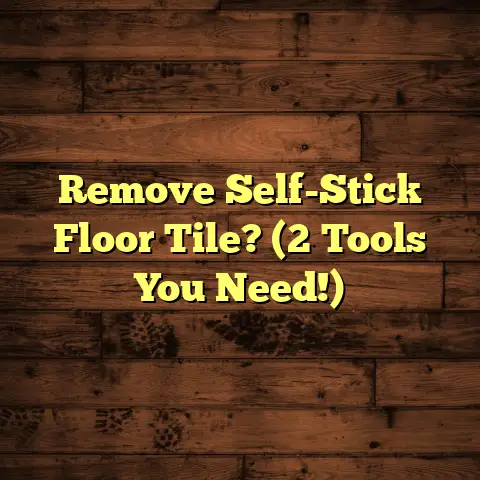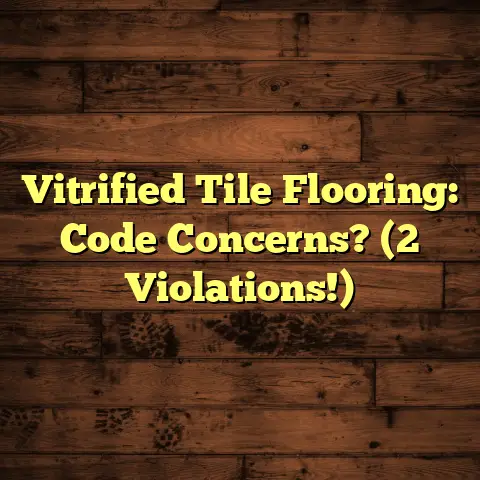Wood Effect Tile: Style & Lasting? (1 Mistake!)
It’s not just a fad; it’s a smart solution for homeowners and designers who want the warmth of wood without the headaches. I’m talking about achieving that beautiful, natural wood look without the constant maintenance or the worry of scratches and water damage. Think of it as the best of both worlds – beauty, durability, and easy living all rolled into one.
Let’s dive in and explore everything you need to know about wood effect tile, including a critical mistake I see people make all the time. Trust me, avoiding this one blunder can save you a lot of heartache and money in the long run.
Section 1: Understanding Wood Effect Tiles
So, what exactly are wood effect tiles? Simply put, they’re tiles designed to mimic the appearance of real wood.
They’re typically made from either ceramic or porcelain, both known for their durability. The magic happens during the manufacturing process.
High-definition printing technology is used to create realistic wood grain patterns on the tile surface. We’re talking about incredibly detailed textures and colors that can fool even the trained eye.
Some manufacturers even add subtle surface variations to mimic the feel of real wood. It’s pretty impressive stuff!
How does it stack up against real hardwood? Well, visually, the best wood effect tiles are incredibly convincing. And practically? That’s where they really shine. We’ll get into the durability aspects later, but think scratch-resistant, waterproof, and easy to clean. A far cry from the delicate nature of some hardwoods!
Section 2: The Aesthetic Appeal of Wood Effect Tiles
One of the biggest reasons wood effect tiles are so popular is their incredible versatility. You’re not limited to just one or two “wood” looks.
The range of styles and designs is truly impressive. Colors range from light, airy blonds to rich, dark browns. Finishes can be matte, glossy, or even textured to replicate the feel of reclaimed wood.
And the patterns? Think classic planks, herringbone, chevron – you name it!
Wood effect tiles can seamlessly complement a huge range of interior design themes. Going for a rustic farmhouse vibe? Choose a distressed wood-look tile in a warm, earthy tone.
Prefer a modern, minimalist aesthetic? Opt for a sleek, light-colored tile with a subtle grain pattern. The possibilities are endless.
Some popular styles mimic specific types of wood, like oak, walnut, maple, and even exotic species. This allows you to achieve the exact look you want without the cost or environmental concerns associated with sourcing rare hardwoods.
Section 3: Durability and Longevity
Okay, let’s talk about the real game-changer: durability. This is where wood effect tiles truly excel.
Compared to natural wood, they’re incredibly resistant to scratches, stains, and moisture. I’ve seen it firsthand in countless homes.
Think about it: you can spill red wine, track in muddy boots, or even have a pet accident without worrying about permanent damage. Try doing that on a hardwood floor!
This inherent durability translates to exceptional longevity. Wood effect tiles can last for decades with proper care, even in high-traffic areas like hallways and kitchens.
And unlike wood, they won’t warp or rot in damp environments like bathrooms or basements. That’s a huge plus for homeowners.
I’ve personally installed wood effect tiles in homes with kids, pets, and busy families. The feedback I get is consistently positive.
They love the look of wood without the stress of constantly worrying about damage. I’ve even had clients tell me they’re easier to maintain than their previous tile floors!
Section 4: The One Critical Mistake to Avoid
Alright, let’s get to the heart of the matter. I’ve seen it happen time and time again: homeowners make one critical mistake when choosing or installing wood effect tiles, and it completely ruins the overall result.
What is it? Choosing the wrong grout color.
I know, it sounds simple, but trust me, it’s a huge deal. The grout is the “glue” that holds your tiles together, and its color can dramatically impact the look of your floor.
The mistake? Using a grout color that’s too contrasting with the tile.
Imagine you’ve chosen a beautiful, light oak-look tile. Then, you pair it with a dark gray or black grout. The result? A busy, disjointed look that completely detracts from the natural beauty of the “wood.”
Instead of a seamless, flowing floor, you end up with a grid-like pattern that highlights the individual tiles rather than the overall design. It makes the floor look cheap and artificial, even if you’ve invested in high-quality tiles.
I’ve seen this mistake cost homeowners thousands of dollars. They end up hating their new floor and having to redo the entire project.
How do you avoid this disaster? Simple: choose a grout color that closely matches the dominant color of your tile.
You want the grout lines to blend in, creating a more unified and natural look. If you’re unsure, err on the side of a slightly lighter shade.
Another tip? Bring a sample of your tile to the store and hold it up against different grout colors. Don’t rely on online images or color charts alone.
Seeing the colors together in person is crucial. And when in doubt, ask for help! A good tile salesperson can offer valuable advice.
Section 5: Installation Process and Tips
Okay, you’ve chosen the perfect wood effect tile and avoided the grout color pitfall. Now, let’s talk about installation.
While some experienced DIYers might be comfortable tackling this project, I generally recommend hiring a professional installer. Why? Because proper installation is crucial for the longevity and appearance of your floor.
Here’s a quick overview of the process:
-
Preparation: This is the most important step! The subfloor must be clean, level, and structurally sound. Any imperfections will telegraph through to the finished floor.
-
Layout Planning: A good installer will carefully plan the layout to minimize cuts and ensure a balanced look. They’ll also consider the direction of the “wood grain” and how it will impact the overall aesthetic.
-
Adhesive Application: The right adhesive is crucial for a strong, lasting bond. Your installer will choose an adhesive specifically designed for your type of tile and subfloor.
-
Tile Placement: This requires precision and attention to detail. Tiles must be properly spaced and aligned to create a seamless look.
-
Grouting: Once the adhesive has cured, the grout is applied to fill the gaps between the tiles. As we discussed earlier, choosing the right grout color is essential.
-
Sealing: Finally, the grout is sealed to protect it from stains and moisture.
Here are a few tips for achieving the best results:
-
Use a leveling system: This will help ensure that your tiles are perfectly even, eliminating any lippage (uneven edges).
-
Maintain consistent grout lines: Use spacers to ensure uniform grout lines throughout the floor.
-
Allow for expansion: Leave a small gap around the perimeter of the room to allow for expansion and contraction.
-
Don’t rush the process: Take your time and pay attention to detail. A well-installed floor is an investment that will last for years to come.
While DIY installation is possible, consider your skill level and the complexity of the project. A professional installer has the experience, tools, and expertise to ensure a flawless result.
Section 6: Maintenance and Care
One of the best things about wood effect tiles is their ease of maintenance. Unlike real wood, they don’t require special cleaners, polishing, or refinishing.
Here’s a simple routine to keep your wood effect tiles looking their best:
-
Regular Sweeping or Vacuuming: Remove loose dirt and debris to prevent scratching.
-
Damp Mopping: Use a mild detergent and warm water to clean the floor. Avoid harsh chemicals or abrasive cleaners.
-
Spot Cleaning: Clean up spills immediately to prevent staining.
-
Grout Cleaning: Periodically clean the grout lines with a grout brush and a mild bleach solution.
Compared to traditional wood flooring, the maintenance of wood effect tiles is a breeze. You don’t have to worry about sanding, sealing, or waxing.
And you can use virtually any type of cleaning product without damaging the surface. It’s a huge time-saver for busy homeowners.
Section 7: Cost Considerations
Let’s talk about the bottom line: cost. Wood effect tiles typically range in price from \$3 to \$10 per square foot, depending on the quality, style, and brand.
Installation costs can vary depending on the complexity of the project and the installer’s rates. Expect to pay anywhere from \$3 to \$8 per square foot for professional installation.
Compared to traditional wood flooring, wood effect tiles can be a more affordable option, especially when you factor in the long-term costs of maintenance and repairs.
While hardwood floors may initially seem cheaper, they require ongoing maintenance, such as refinishing every few years, which can add up over time.
Wood effect tiles, on the other hand, require minimal maintenance and can last for decades without needing to be replaced.
When considering resale value, wood effect tiles can be a smart investment. They offer the aesthetic appeal of wood without the drawbacks, making them an attractive feature for potential buyers.
Section 8: Conclusion
So, there you have it: a comprehensive overview of wood effect tiles. They offer a winning combination of style, durability, and ease of maintenance.
They’re a smart choice for homeowners who want the look of wood without the headaches.
Remember that one critical mistake: choosing the wrong grout color. It can make or break the entire project.
Take your time, do your research, and choose a grout color that complements your tile.
I encourage you to explore wood effect tiles for your next flooring project. They’re a stylish, lasting solution that will add beauty and value to your home.
And if you’re feeling overwhelmed, don’t hesitate to consult with a professional flooring contractor. We can help you choose the right tile, avoid common mistakes, and ensure a flawless installation.
Happy flooring!





